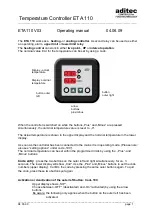
Temperature Controller ETA 110
_________________________________________________________________________________________________________
_________________________________________________________________________________
04.06.09 page 5
Safety instructions
To avoid any danger of electrocution, the housing must never be removed nor opened at the back. There
are no parts inside that can be serviced by the user himself. Leave the servicing to the experts! To avoid
a fire or electrocution the appliance must not get wet nor be exposed to rain.
1. Advice:
Read all safety instructions and all items in the user manual, before using the controller for the
first time! Keep the safety instructions and the user manual in a safe place in case you need to refer back
to it at a later date!
2. Installation instructions:
Always make sure that the appliance is installed by an authorized and
experienced specialist. Please follow the specific safety instructions as well as the VDE guidelines during
installation. The appliance should only be fitted in an approved and specifically designed waterproof
switching cabinet (metal housing) and should only be used for the purpose it was designed for and within
the limits of its technical data.
We recommend that any down-streamed inductors with RC elements should be checked for
interference. These are available on the retail market (e.g. Siemens 3 RT1916).
3.
Analogue in- and outputs:
To the in- and outputs (4-20mA / 0-10V and Pt100) do not apply separate
source voltage.
4. Sensor leads: The leads for the sensors should be run separately from any voltage carrying
leads, this also includes control wires carrying separate source voltage. It is vitally important that
the sensor leads have a metal shielding and that this shielding is connected to the sensor
housing itself.
5. Relay outputs:
The relay outputs are potential free and the maximal load of 250V AC and 4A must not
overshoot.
6. Water and humidity:
Never use the unprotected appliance near water, e.g. near a bath tub, water
basin, sink, washing machine, a damp cellar or near a swimming pool. The appliance is only waterproof
on the front (IP67). The back and side panels must not come into contact with water.
7. Ventilation:
The appliance must have sufficient ventilation, the ventilation slits in the housing must
never be covered up, or blocked by objects that may have been inserted into the slits.
8. The effects of heat:
Keep the appliance away from heat sources, like radiators, heating conduits,
ovens, and other elements that may radiate heat.
9. Energy sources:
The appliance should only be connected to the power sources that are specified in
the service manual or on the appliance housing itself.
10. Cleaning:
When cleaning the appliance, keep to the recommendations given by the manufacturer.
11. Appliance not in use:
When you know the appliance is not going to be used for a longer period of
time, it should be disconnected from the mains.
12. Contaminants:
You have to be extremely careful that neither liquids nor foreign objects can get into
the appliance through the openings in the housing. If objects or liquids have contaminated the inside of
the appliance, it has to be disconnected and sent in to the manufacturer immediately.
13. Servicing after damage:
The appliance may only be serviced by a qualified specialist. The user
should only do the servicing tasks he is meant to do according to the service manual. For servicing that
exceed his authority, he should always contract a specialist.
14. Please note: Never make any technical alterations to the appliances,
unless they were
specifically approved by aditec GmbH.
Unauthorized alterations will invalidate your warranty.
























